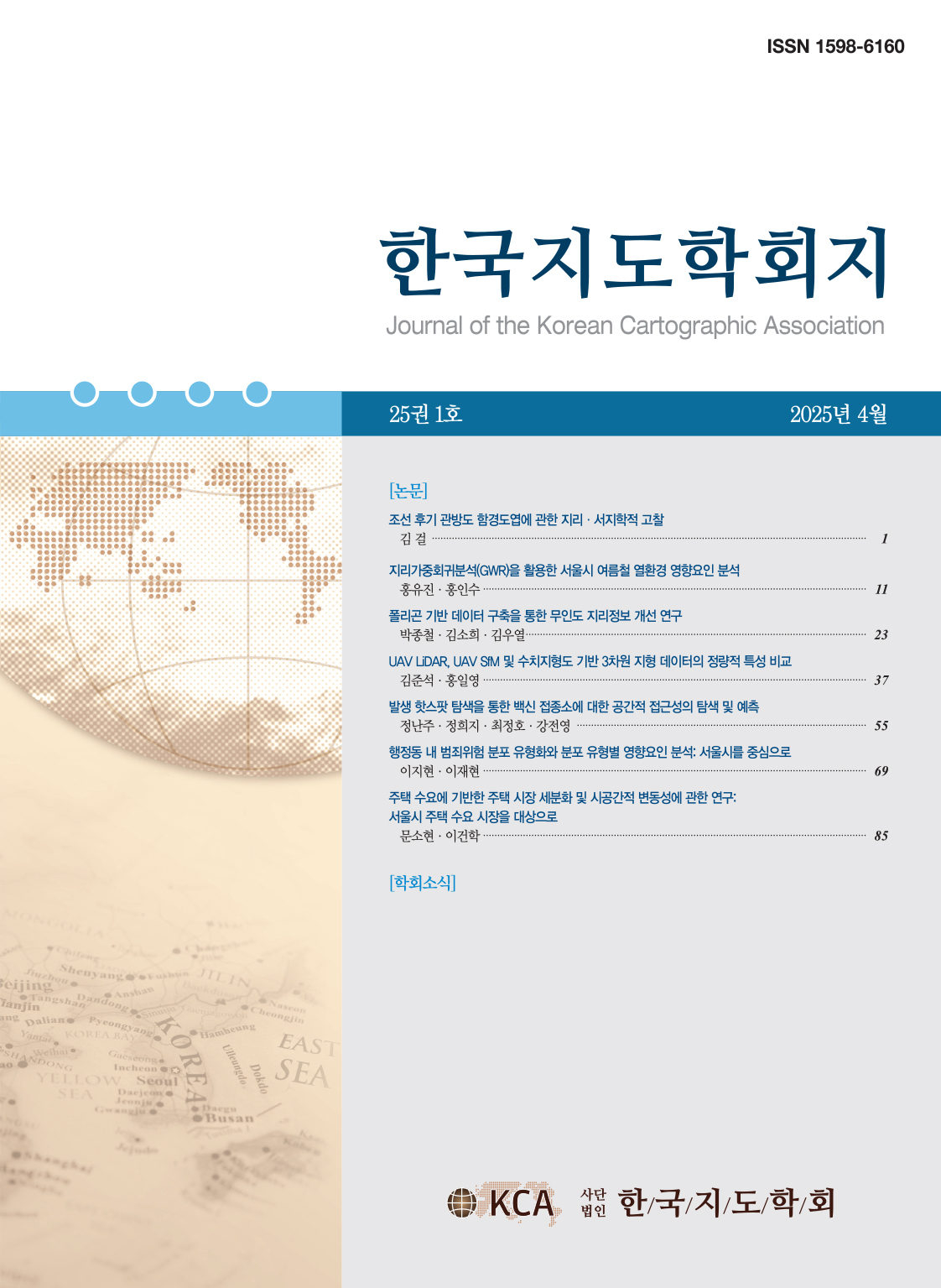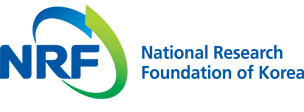Research Article
Abstract
References
Information
The aim of this research is to examine the economic and spatial agglomerations of knowledge-based industries. To investigate economic agglomerations, indices of specialization, diversity and competition were calculated and compared across the metropolitan regions in Korea. Additionally, Getis and Ord’s Gi* was used to identify hot spots assessing the extent of spatial agglomerations while accounting for spatial autocorrelations. The results reveal the presence of specific hot spots based on the type of knowledge-based manufacturing or service industry and the metropolitan region. The largest industrial cluster of knowledge-based service industries was found in the central areas of Seoul metropolitan region.
본 연구의 목적은 대도시 지역의 산업구조 변화에 따라 중요성이 강조되어온 지식기반산업의 경제 및 공간 집적에 주목하고 그 특성을 실증적으로 분석하는 것이다. 우리나라 광역도시권을 연구 지역으로 선정하고, 경제 집적을 측정하기 위하여 지식기반산업의 특화도, 다양성, 경쟁도를 나타내는 지수를 산출하여 집적의 정도를 비교하는 한편, 공간적 측면에서는 공간자기상관을 기반으로 하는 Getis and Ord’s Gi*를 이용하여 집적 정도를 측정하였다. 분석 공간단위는 광역도시권과 시군구 수준으로 구분하였다. 지식기반산업을 지식기반제조업과 지식기반서비스업으로 구분하여 경제 및 공간 집적을 분석한 결과, 각 산업 부문과 광역도시권에 따라 차별적으로 집적이 이루어지고 있음을 확인하였다. 또한 4개의 산업집적 지역유형 중 산업 특화도와 공간자기상관이 높은 유형인 산업집적 클러스터를 확인한 결과, 가장 큰 규모는 지식기반서비스업에서 나타났는데, 그 공간 범위는 서울의 대다수 구 지역과 인접 시구 지역을 포함한다.
- 김군수・이원영・성영조・강승우・신민경, 2007, 「경기도 산업발전 비전수립 연구」, 수원: 경기개발연구원.
- 김명진, 2014, “Getis-Ord’s Gi*와 FLQ를 이용한 공간 집적 분석: 경기도 지식기반산업을 대상으로,” 한국지도학회지, 14(1), 107-123.
- 김성희, 2020, “공간단위별 산업집적 분석 방법 연구: 뿌리산업을 중심으로,” 한국콘텐츠학회논문지, 20(6), 256-266. https://doi.org/10.5392/JKCA.2020.20.06.25610.5392/JKCA.2020.20.06.256
- 김영수, 2003, 「지식기반산업의 지역별 발전동향과 정책시사점」, 서울: 산업연구원.
- 김헌민・박윤경, 2015, “광역자치단체 경제발전과 지식기반산업의 관계에 관한 연구,” 한국지방자치학회보, 27(3), 31-51. https://dx.doi.org/10.21026/jlgs.2015.27.3.3110.21026/jlgs.2015.27.3.31 t
- 김희연・정수연, 2023, “제주지역 지식기반산업의 생산성 결정요인에 관한 연구,” 산업경제연구, 36(2), 245-280. http://dx.doi.org/10.22558/jieb.2023.4.36.2.245 10.22558/jieb.2023.4.36.2.245
- 류나영, 2020a, “우리나라 광역도시권의 스프롤 연구: 스프롤의 측정과 스프롤이 통근에 미치는 영향을 중심으로,” 서울대학교 대학원 박사학위논문.
- 류나영, 2020b, “광역도시권의 스프롤 특성: 시군구 스케일의 다차원적 스프롤 측정을 중심으로,” 한국지리학회지, 9(3), 549-565. https://doi.org/10.25202/JAKG.9.3.7 10.25202/JAKG.9.3.7
- 류나영, 2024, “서울광역도시권의 도시 스프롤과 통근 패턴간 관련성 연구,” 한국지도학회지, 24(1), 19-32. https://doi.org/10.16879/jkca.2024.24.1.019 10.16879/jkca.2024.24.1.019
- 류나영・신정엽, 2020, “광역도시권의 스프롤 변화 양상: 광역도시권의 설정과 밀도 기반의 인구 및 고용 스프롤 측정을 중심으로,” 한국지리학회지, 9(2), 395-409. https://doi.org/10.25202/JAKG.9.2.11 10.25202/JAKG.9.2.11
- 류나영・홍인수, 2020, “도시 스프롤이 통근 패턴에 미치는 영향: 우리나라 광역도시권을 사례로,” 한국지도학회지, 20(3), 73-92. https://doi.org/10.16879/jkca.2020.20.3.073 10.16879/jkca.2020.20.3.073
- 모영민・강명헌, 2015, “권역별 산업구조가 지역경제에 미치는 영향에 관한 연구,” 한국지역경제연구, 13(1), 81-100.
- 박고운・이원호, 2009, “우리나라 도시경쟁력과 지식기반산업 성장의 상관관계 분석,” 응용지리, 28, 57-75.
- 송해안, 2003, “전북과 충남지역 지식기반산업의 성장요인 비교분석,” 산업경제연구, 16(6), 195-213. 10.1023/A:1023227503176
- 안보광, 2013, “산업집적이 지역경제에 미치는 영향에 관한 연구: 충청광역경제권 제조업을 중심으로,” 서울대학교 행정대학원 석사학위논문.
- 이정현・이희연, 2017, “지식기반산업 창업기업의 고용창출 효과,” 한국경제지리학회지, 20(2), 137-157. http://dx.doi.org/10.23841/egsk.2017.20.2.137 10.23841/egsk.2017.20.2.137
- 임창호・김정섭, 2003, “산업집적의 외부효과가 도시경제성장에 미치는 영향,” 국토계획, 38(3), 187-201.
- 최문형・정문기, 2021, “지식기반산업의 산업구조와 지역경제성과의 영향연구: 전국 기초자치단체를 중심으로,” 한국지방자치학회보, 33(1), 27-52. http://dx.doi.org/10.21026/jlgs.2021.33.1.27 10.21026/jlgs.2021.33.1.27
- 홍길종・김형철, 2022, “강원도 데이터산업 특화도 분석과 기업지원 전략에 관한 연구,” 한국사진지리학회지, 32(3), 45-60. https://doi.org/10.35149/jakpg.2022.32.3.004 10.35149/jakpg.2022.32.3.004
- Arrow, K.J., 1962, The economic implications of learning by doing, The Review of Economic Studies, 29(3), 155-173. https://doi.org/10.2307/2295952 10.2307/2295952
- Audretsch, D.B., 1998, Agglomeration and the location of innovative activity, Oxford Review of Econonic Policy, 14(2), 18-29. https://doi.org/10.1093/oxrep/14.2.18 10.1093/oxrep/14.2.18
- Barff, R.A., 1987, Industrial clustering and the organization of production: A point pattern analysis of manufacturing in Cincinnati, Ohio, Annals of the Association of American Geographers, 77(1), 89-103. https://doi.org/10.1111/j.1467-8306.1987.tb00147.x 10.1111/j.1467-8306.1987.tb00147.x
- Castro, M.C. and Singer, B.H., 2006, Controlling the false discovery rate: A new application to account for multiple and dependent tests in local statistics of spatial association, Geographical Analysis, 38(2), 180-208. https://doi.org/10.1111/j.0016-7363.2006.00682.x 10.1111/j.0016-7363.2006.00682.x
- Feldman, M.P. and Audretsch, D.B., 1999, Innovation in cities: Science-based diversity, specialization and localized competition, European Economic Review, 43(2), 409-429. https://doi.org/10.1016/S0014-2921(98)00047-6 10.1016/S0014-2921(98)00047-6
- Flegg, A.T. and Tohmo, T., 2013, Regional input–output tables and the FLQ formula: A case study of Finland, Regional Studies, 47(5), 703-721. https://doi.org/10.1080/00343404.2011.592138 10.1080/00343404.2011.592138
- Flegg, A.T. and Webber, C.D., 1997, On the appropriate use of location quotients in generating regional input‐output tables: Reply, Regional Studies, 31(8), 795-805. https://doi.org/10.1080/713693401 10.1080/713693401
- Flegg, A.T. and Webber, C.D., 2000, Regional size, regional specialization and the FLQ formula, Regional Studies, 34(6), 563-569. https://doi.org/10.1080/00343400050085675 10.1080/00343400050085675
- Flegg, A.T., Webber, C.D., and Elliott, M.V., 1995, On the appropriate use of location quotients in generating regional input‐output tables, Regional Studies, 29(6), 547-561. https://doi.org/10.1080/00343409512331349173 10.1080/00343409512331349173
- Glaeser, E.L., Kallal, H.D., Scheinkman, J.A., and Shleifer, A., 1992, Growth in cities, Journal of Political Economy, 100(6), 1126-1152. https://doi.org/10.1086/261856 10.1086/261856
- Globerman, S., Shapiro, D., and Vining, A., 2005, Clusters and intercluster spillovers: Their influence on the growth and survival of Canadian information technology firms, Industrial Corporate Change, 14(1), 27-60. https://doi.org/10.1093/icc/dth043 10.1093/icc/dth043
- Guillain, R., Le Gallo, J., and Boîteux-Orain, C., 2006, Changes in spatial and sectoral patterns of employment in Ile-de-France, 1978-1997, Urban Studies, 43(11), 2075-2098. https://doi.org/10.1080/00420980600945203 10.1080/00420980600945203
- Hall, P.G. and Pain, K., eds., 2006, The Polycentric Metropolis: Learning from Mega-city Regions in Europe, London: Earthscan.
- Jacobs, J., 1969, The Economy of Cities, New York: Vintage.
- Kloosterman, R.C. and Lambregts, B., 2001, Clustering of economic activities in polycentric urban regions: The case of the Randstad, Urban Studies, 38(4), 717-732. https://doi.org/10.1080/00420980120035303 10.1080/00420980120035303
- Maskell, P., 2001, Towards a Knowledge‐based theory of the geographical cluster, Industrial and Corporate Change, 10(4), 921-943. https://doi.org/10.1093/icc/10.4.921 10.1093/icc/10.4.921
- Marshall, A., 1890, Principles of Economics, London: Macmillan and Co.
- Moreno, R., Paci, R., and Usai, S., 2005, Geographical and sectoral clusters of innovation in Europe, The Annals of Regional Science, 39(4), 715-739. https://doi.org/10.1007/s00168-005-0021-y 10.1007/s00168-005-0021-y
- Paci, R. and Usai, S., 1999, Externalities, knowledge spillovers and the spatial distribution of innovation, GeoJournal, 49(4), 381-390. https://doi.org/10.1023/A:1007192313098 10.1023/A:1007192313098
- Parr, J.B., 2002, Agglomeration economies: Ambiguities and confusions, Environment and Planning A: Economy and Space, 34(4), 717-731. https://doi.org/10.1068/a34106 10.1068/a34106
- Parr, J.B., 2004, The polycentric urban region: A closer inspection, Regional Studies, 38(3), 231-240. https://doi.org/10.1080/003434042000211114 10.1080/003434042000211114
- Parr, J.B., 2005, Perspectives on the city‐region, Regional Studies, 39(5), 555-566. https://doi.org/10.1080/00343400500151798 10.1080/00343400500151798
- Porter, M.E., 1990, The Competitive Advantage of Nations, New York: Free Press. 10.1007/978-1-349-11336-1
- Romer, P.M., 1986, Increasing returns and long-run growth, Journal of Political Economy, 94(5), 1002-1037. https://doi.org/10.1086/261420 10.1086/261420
- Shin, J., 2005, Review on the urban economic cluster in the economic and geographic contexts, Journal of Geography Education, 49, 203-216.
- Tichy, G., 1998, Clusters: Less dispensable and more risk than ever, in Steiner, M., ed., Clusters and Regional Specialisation: On Geography, Technology and Networks, London: Pion, 226-237.
- Yeates, M., 1998, The North American City, 5th ed., New York: Longman.
- 통계청 국가통계포털, https://kosis.kr
- 통계청 통계지리정보서비스, https://sgis.kostat.go.kr
- Publisher :The Korean Cartographic Association
- Publisher(Ko) :한국지도학회
- Journal Title :Journal of the Korean Cartographic Association
- Journal Title(Ko) :한국지도학회지
- Volume : 24
- No :2
- Pages :23~41
- DOI :https://doi.org/10.16879/jkca.2024.24.2.023



 Journal of the Korean Cartographic Association
Journal of the Korean Cartographic Association





